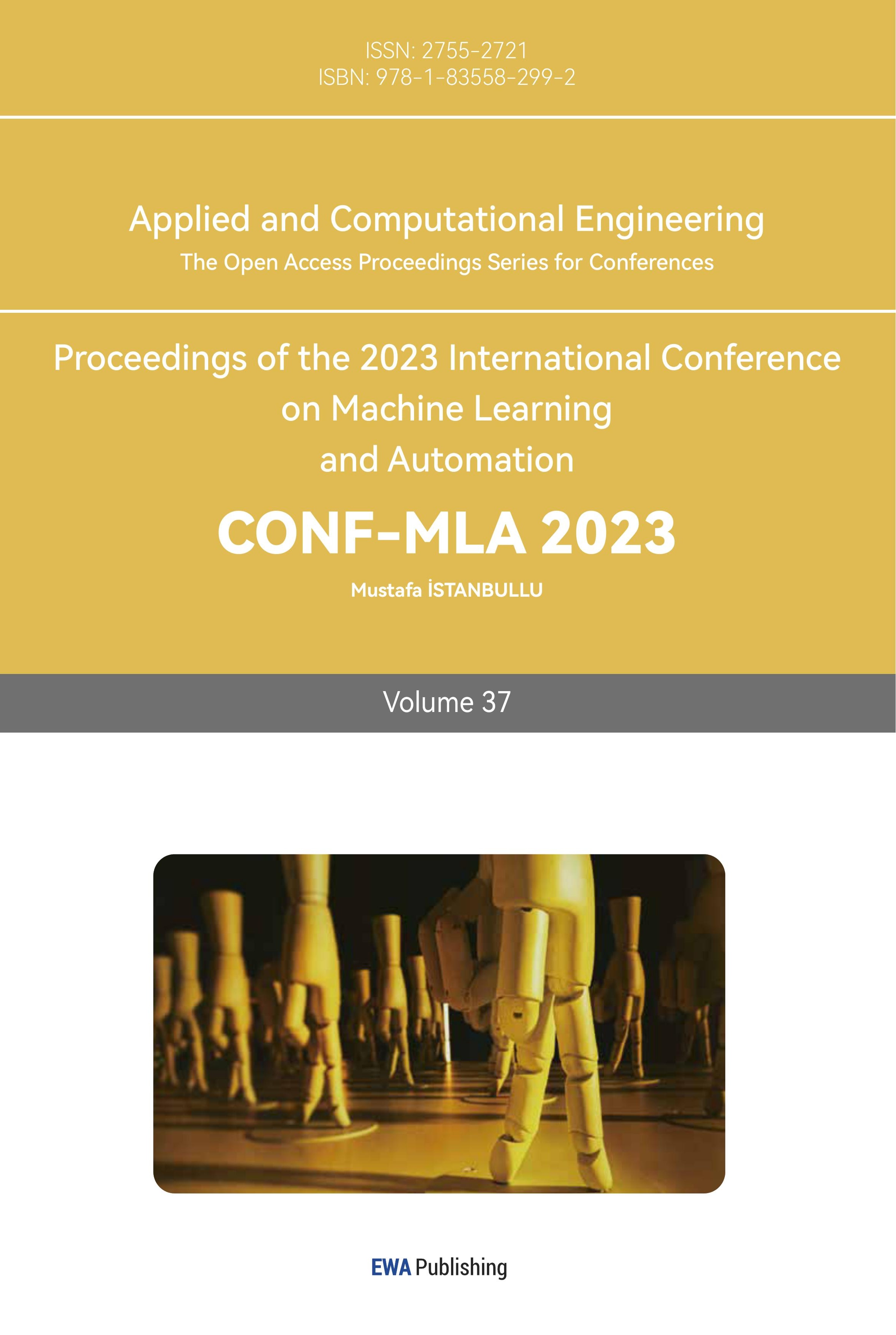References
[1]. Li X and Hao X 2021 English Machine Translation Model Based on Artificial Intelligence Journal of Physics: Conference Series 1982
[2]. Zhou L 2016 Machine Translation Based on Translation Rules for Processing Natural Language Proceedings of 2016 6th International Conference on Machinery,Materials,Environment,Biotechnology and Computer(MMEBC 2016) 488-91
[3]. Vogel S, Och F J, Tillmann C, Nießen S, Sawaf H and Ney H 2000 Statistical Methods for Machine Translation Verbmobil: Foundations of Speech-to-Speech Translation 377-93
[4]. Bengio Y, Ducharme R, Vincent P and Janvin C 2003 A Neural Probabilistic Language Model J. Mach. Learn. Res. 3 1137-55
[5]. Vaswani A, Shazeer N, Parmar N, Uszkoreit J, Jones L, Gomez A N, Kaiser L and Polosukhin I 2017 Attention is All you Need Advances in Neural Information Processing Systems 30
[6]. Liu Z 2022 Ancient-Modern Chinese Machine Translation Models Based On Transformer East China Normal University 11 103
[7]. Zhou C and Liu Z 2022 Ancient Text Machine Translation Method Based on Semantic Information Sharing Transformer Technology Intelligence Engineering 8 114-27
[8]. Chung J, Gulcehre C, Cho K H and Bengio Y 2014 Empirical Evaluation of Gated Recurrent Neural Networks on Sequence Modeling ArXiv https://doi.org/10.48550/arXiv.1412.3555
[9]. Huang A, Subramanian S, Sum J, Almubarak K and Biderman S 2022 The Annotated Transformer http://nlp.seas.harvard.edu/annotated-transformer/
[10]. Zhou D, He W and Gang C 2011 Research on Tibetan Text Classification Based on N-Gram Model 2011 13th IEEE Joint International Computer Science and Information Technology Conference(JICSIT 2011) 02
[11]. Kim N S, Baldwin T and Kan M-Y 2010 Evaluating N-gram Based Evaluation Metrics for Automatic Keyphrase Extraction The 23rd International Conference on Computational Linguistics Proceedings of the Main Conference 1
[12]. Cui D, Liu X, Chen R, Liu X, Li Z and Qi L 2020 Named Entity Recognition in Field of Ancient Chinese Based on Lattice LSTM Computer Science 47 18-22.
[13]. Zeng X 2019 Technology Implementation of Chinese Jieba Segmentation Based on Python [J]. China Computer & Communication 31 38-39+42.
[14]. Papineni K, Roukos S, Ward T and Zhu W J 2002 BLEU: A Method for Automatic Evaluation of Machine Translation Association for Computational Linguistics 311-8
Cite this article
Ju,Z.;Xin,Y.;Ye,M. (2024). Machine translation of classical Chinese based on unigram segmentation transformer framework. Applied and Computational Engineering,37,23-30.
Data availability
The datasets used and/or analyzed during the current study will be available from the authors upon reasonable request.
Disclaimer/Publisher's Note
The statements, opinions and data contained in all publications are solely those of the individual author(s) and contributor(s) and not of EWA Publishing and/or the editor(s). EWA Publishing and/or the editor(s) disclaim responsibility for any injury to people or property resulting from any ideas, methods, instructions or products referred to in the content.
About volume
Volume title: Proceedings of the 2023 International Conference on Machine Learning and Automation
© 2024 by the author(s). Licensee EWA Publishing, Oxford, UK. This article is an open access article distributed under the terms and
conditions of the Creative Commons Attribution (CC BY) license. Authors who
publish this series agree to the following terms:
1. Authors retain copyright and grant the series right of first publication with the work simultaneously licensed under a Creative Commons
Attribution License that allows others to share the work with an acknowledgment of the work's authorship and initial publication in this
series.
2. Authors are able to enter into separate, additional contractual arrangements for the non-exclusive distribution of the series's published
version of the work (e.g., post it to an institutional repository or publish it in a book), with an acknowledgment of its initial
publication in this series.
3. Authors are permitted and encouraged to post their work online (e.g., in institutional repositories or on their website) prior to and
during the submission process, as it can lead to productive exchanges, as well as earlier and greater citation of published work (See
Open access policy for details).
References
[1]. Li X and Hao X 2021 English Machine Translation Model Based on Artificial Intelligence Journal of Physics: Conference Series 1982
[2]. Zhou L 2016 Machine Translation Based on Translation Rules for Processing Natural Language Proceedings of 2016 6th International Conference on Machinery,Materials,Environment,Biotechnology and Computer(MMEBC 2016) 488-91
[3]. Vogel S, Och F J, Tillmann C, Nießen S, Sawaf H and Ney H 2000 Statistical Methods for Machine Translation Verbmobil: Foundations of Speech-to-Speech Translation 377-93
[4]. Bengio Y, Ducharme R, Vincent P and Janvin C 2003 A Neural Probabilistic Language Model J. Mach. Learn. Res. 3 1137-55
[5]. Vaswani A, Shazeer N, Parmar N, Uszkoreit J, Jones L, Gomez A N, Kaiser L and Polosukhin I 2017 Attention is All you Need Advances in Neural Information Processing Systems 30
[6]. Liu Z 2022 Ancient-Modern Chinese Machine Translation Models Based On Transformer East China Normal University 11 103
[7]. Zhou C and Liu Z 2022 Ancient Text Machine Translation Method Based on Semantic Information Sharing Transformer Technology Intelligence Engineering 8 114-27
[8]. Chung J, Gulcehre C, Cho K H and Bengio Y 2014 Empirical Evaluation of Gated Recurrent Neural Networks on Sequence Modeling ArXiv https://doi.org/10.48550/arXiv.1412.3555
[9]. Huang A, Subramanian S, Sum J, Almubarak K and Biderman S 2022 The Annotated Transformer http://nlp.seas.harvard.edu/annotated-transformer/
[10]. Zhou D, He W and Gang C 2011 Research on Tibetan Text Classification Based on N-Gram Model 2011 13th IEEE Joint International Computer Science and Information Technology Conference(JICSIT 2011) 02
[11]. Kim N S, Baldwin T and Kan M-Y 2010 Evaluating N-gram Based Evaluation Metrics for Automatic Keyphrase Extraction The 23rd International Conference on Computational Linguistics Proceedings of the Main Conference 1
[12]. Cui D, Liu X, Chen R, Liu X, Li Z and Qi L 2020 Named Entity Recognition in Field of Ancient Chinese Based on Lattice LSTM Computer Science 47 18-22.
[13]. Zeng X 2019 Technology Implementation of Chinese Jieba Segmentation Based on Python [J]. China Computer & Communication 31 38-39+42.
[14]. Papineni K, Roukos S, Ward T and Zhu W J 2002 BLEU: A Method for Automatic Evaluation of Machine Translation Association for Computational Linguistics 311-8









